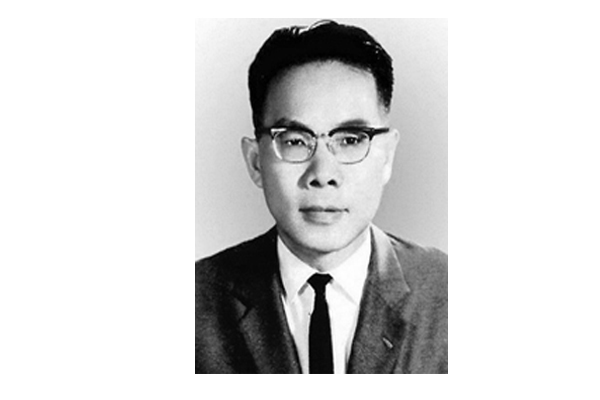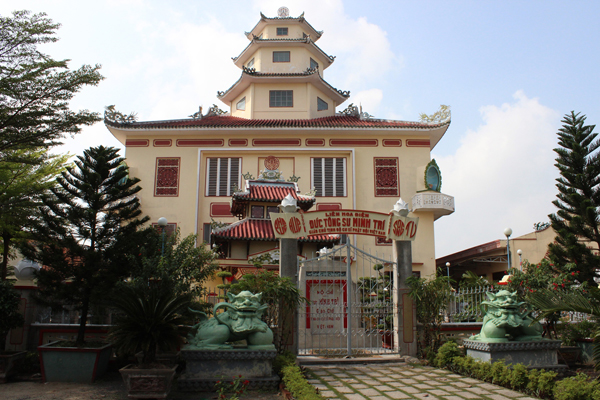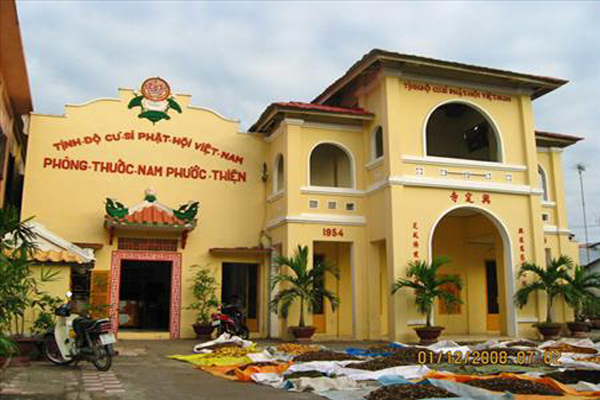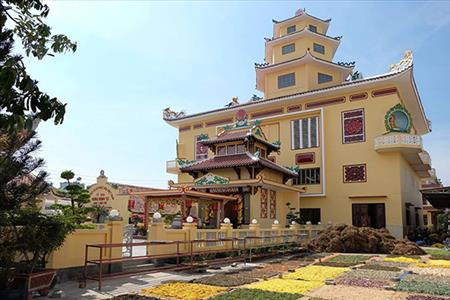Tinh Do Cu Si Phat Hoi Vietnam (Vietnam Pure Land Buddhist Home-Practice Association) was born in South Vietnam in the first half of the twentieth century when a movement to revive Buddhism took place. Its founder was Nguyen Van Bong (1886- 1958), and he was born in Tan My Commune, An Thanh Thuong District, Sa Dec Province (present-day Dong Thap Province). In his childhood, Nguyen Van Bong learned Confucianism. When growing up, he studied Buddhism and traditional medicine. Being a patriot, he had been enlightened from an early age to the truth of Buddhism. In addition, he was under the influence of the movement in the early twentieth century to revive Buddhism. Therefore, he became more concerned about religion and life.
Nguyen Van Bong made use of his knowledge of Buddhism to transform the tenets into poetry, and prayer-books into Buddhist admonitions, which were brief and straightforward. His work helped people become aware of the Buddhist tenet systems. Nguyen Van Bong was called Duc Tong Su Minh Tri (Minh Tri- the Head of Buddhism).

Based on Buddhist tenets that were interpreted in a suitably straightforward way for the people in South Vietnam, Tinh Do Cu Si Phat Hoi Vietnam advocated the religious practice motto “Phuoc – Hue song tu.” “Tu Phuoc” means to make intellectual and material contributions to practicing charity and especially to developing traditional medicine through dispensaries, providing free examinations for the poor. This was a good opportunity for the poor to follow Buddhism. “Tu Hue” is the study of the Buddhist scriptures, canon laws, and theories to enhance intelligence and knowledge, aiming at a peaceful and happy life. It is believed that “Tu Phuoc” and “Tu Hue” have a close relationship with each other. They complement each other and impel mutual development within a person’s mind. Based on that feature, they are spread widely in society, helping to build a united friendly society.
The aforementioned tenets of this religion are described in seven prayer books: Le bai luc phuong or Kowtowing in Six Directions (about anchorites who actively join daily activities but still keep their temper tranquil), Phu the ngon luan (encouraging followers to be determined from mind to action), Dao duc – Phuong phap thuc hanh or Morality – Methods of Practice (about the significance and methods of moral practice in civilized and scientific society), Gioi luat or Commandments (about commandments that anchorites should observe to make achievements as monks do), Phat hoc van dap or Questions and Answers about Buddhist Studies (giving explanations about the Sangha, the Three Refuges and the Five Precepts, which are the bases for identifying the true value of anchorites), Phuoc – Hue song tu (about how to practice Buddhism along with humanity) and Phuong phap kien tanh (presenting the operational method of consciousness beyond what is perceived by the senses).
The followers of Tinh Do Cu Si Phat Hoi have to take the Three Refuges (Buddha, Dharma, and Sangha) and observe the Five Precepts (abstaining from killing, stealing, sexual misconduct, lying, and intoxication). In addition, they can practice at higher levels, depending on their ability.
There are no monks in this religion, only members and anchorites. There are six kinds of members as follows: founding members, honorary members, charitable members, auxiliary members, active members, and preaching members. Anchorites have to take refuge in the Buddha, Dharma, and Sangha. The places of worship are called society’s premises, which are also charitable dispensaries.

The rites of this religion are simple, but they are solemn and respectful. At first, Minh Tri applied Le bai Luc phuong, which meant kowtowing in six directions (the East symbolizes parents, the South represents literacy teachers, the West symbolizes husband and wife, the North represents friends, the Upper means religious teachers, and the Lower represents servants), as the main rites. Each of these directions requires kowtowing four times. Then, he re-stipulated that kowtowing to the Buddhist altar 24 times was enough. When kowtowing, the head, two hands, and knees must touch the ground; the two hands’ palms must face the ground.
The followers of this religion have their own traditional clothes. Males wear long tunics and black turbans. Females wear tunics in white or deep blue. Anchorites (both male and female) living in pagodas wear ao ba ba (a kind of shirt used by South Vietnamese people) in white or deep blue.
Tinh Do Cu Si Phat Hoi Vietnam holds two great anniversaries annually according to the lunar calendar. Every April 8, the anniversary of Buddha’s Birthday and the Annual Congress on Health and Charity are held. Its Central Executive Committee is also elected the same day. Every August 23, the anniversary of Duc Tong Su’s death day and the Annual Congress on Morality are held.
Ceremonies are also held on the first and fifteenth days very lunar month to admit new followers and preach tenets. Buddhist festivals such as the Wandering Souls Day (July 15) are also celebrated by followers of Tinh Do Cu Si Phat Hoi Vietnam.

In addition, followers also conduct daily rites at home or at places of worship according to the following regulation: kowtowing to Buddha twenty-four times, to Bodhisattva twelve times, and to Duc Tong Su six times.
Tinh Do Cu Si Phat Hoi Vietnam was first regarded as a Buddhist sect. However, due to its specific characteristics in practice, it could function as an independent religion and be licensed for operation as a religious organization by the French authorities (License No. 619 dated February 20, 1934). Later, it was officially recognized by the Sai Gon authorities through the issuance of the Decree No. 83/MI/DAP dated December 22, 1953.
Founded in 1934, Tinh Do Cu Si Phat Hoi Vietnam had seven places of worship, also being seven charitable dispensaries. This number rose to 110 in 1956, 181 in 1971, 185 in 1975, and 201 in 2004. In 2006, it had 206 places of worship (as well as dispensaries) with 4,800 dignitaries, 868 physicians, and nurses and more than 35,000 members in 23 provinces and cities from Khanh Hoa to Ca Mau. After the Liberation of South Vietnam, it did not join the Vietnam Buddhist Sangha at the Buddhist Unification Congress in 1981, but it operated independently due to its different characteristics. On November 21, 2007, the Government Committee for Religious Affairs, authorized by the Vietnamese Prime Minister, issued the Decision No. 207/ QD-TGCP officially recognizing Tinh Do Cu Si Phat Hoi Vietnam. Its head office is located in the Hung Minh Pagoda at 45 Ly Chieu Hoang Street, Ward 10, District 6, Ho Chi Minh City.

